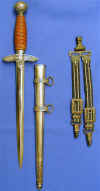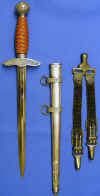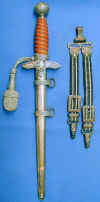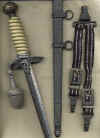|
|
||||||||||||||||||||||||||||||||||||||||||||||||||||||||
|
The Air Force [Luftwaffe]
Hitler, in an attempt to develop the embryonic Luftwaffe to the maximum extent consistent with the state of the art, designated World War I fighter ace Herman Goring as both Commander in Chief of the Air Force and Minister of Aviation. In the latter role, Goring was a member of the Cabinet and was responsible for co-ordinating and supervising all civil air matters. As the Commander in Chief of the Air Force, Reichsmarshal Goring was made responsible for the administration, training, development, procurement, and maintenance of the entire Luftwaffe. Goring organized his new command into two major sections: 1)… Command section (responsible for tactical operations) 2)…Air ministry section (responsible for the maintenance of the Air Force's personnel and equipment and for the control of every aspect of civil and commercial aviation). The Luftwaffe was to play a very significant role throughout World War II, particularly the early years. Its effectiveness was destroyed as attrition took its toll and the allied airforces grew in volume and quality as the war progressed. 3rd Reich Aircraft Production
|
||||||||||||||||||||||||||||||||||||||||||||||||||||||||
Dagger Information – Luftwaffe Type The standard Luftwaffe type 2 dagger had a steel stiletto blade and was 25.5 to 26.5 cm lengths in total. The pommel and cross guard was made from cast aluminium or alloy, some can be found with a sliver anodised finish. An eagle with wings wide open holding a swastika in its talons was cast onto the cross guard face. The top arms have many forms ranging from engraved oak leafed to embossed style. Many of these can be found with a dark oxide finish to a very pale gray finish as well with just darkened backgrounds, to highlight details. The pommel had a gilded swastika at its centre, the swastika’s gold color ranging from a dull bronze to bright gold, surrounded by oak leaves. Again the finish varied greatly from a pale gray to near black finish or just to show highlights. The pommel screwed onto the blade tang to secure the grip, cross guard and blade. Dagger Grips came in a range of colours; white/yellow/orange with silver wire running down the grip in an anticlockwise direction. The wire thread wound around the grip could be very fine, tightly wrapped wire or a few strands of wire twisted together or even a "spongy" wire wrap. This wire can be found in many different colours and materials ranging from brass to aluminium. As with the Army style dagger, extra cost items like real Ivory grips could be acquired. as well as Amber glass grips. Of special note on Luftwaffe 2nd daggers is a variation found from the maker Robert Klaas that has a Black grip with silver wire wrap. Exactly what this dagger was for is not known but it’s a well-known fact that only Klaas made them. The scabbard was made from steel and fitted with two oak leaf covered hanger suspension rings. At the bottom of the scabbard was an enclosed panel where 3 oak leaves rose upwards from the tip. The finish of the scabbards can range from pale grey to a dark grey finish and extra cost finishes of silver and nickel. These were finished with a clear lacquer. Hangers had dual straps with blue/grey fronts and silver woven edges. The rear of the hangers was dark velvet. Hanger buckles were square with oak leaf motifs around the buckle edges. Now and then the U.E. RZM 10 hangers can be found with gold finish. The accoutrements were completed by the addition of a 23 cm silver coloured Portapee. There is also a 23-24 cm Gold tone portepee, as well as silver with black lines in the stem area, though there is no documentation as to why these variations exist. The blade in standard issue had no motto engraved on the blade; they came in a crossgrain polished format as well, some makers used nickel plating. However, some extra cost blades can have etching if used as a presentation offering or customised by the owner. Other extra cost items were damast blades. On some Luftwaffe blades a small eagle like stamping can be found with a 5 or 3 stamped on it. This indicates that it was purchased by the Government to be issued to Officers and high ranking NCO’s that could not or did not buy a dagger for wear at a Government function. Variations could be purchased with extra’s that included ivory grip, engraved or Damascus blades plus upgraded hangers. The Luftwaffe Type 2 dagger entered use in October 1937 and was discontinued from dress wear in December 1944. As with the Army dagger this dagger can be found on rare occasion with a gold finished scabbard done in a dull brass gold finish, possibly for use by officers of the rank of General. Edited by Bruce Petrin |





